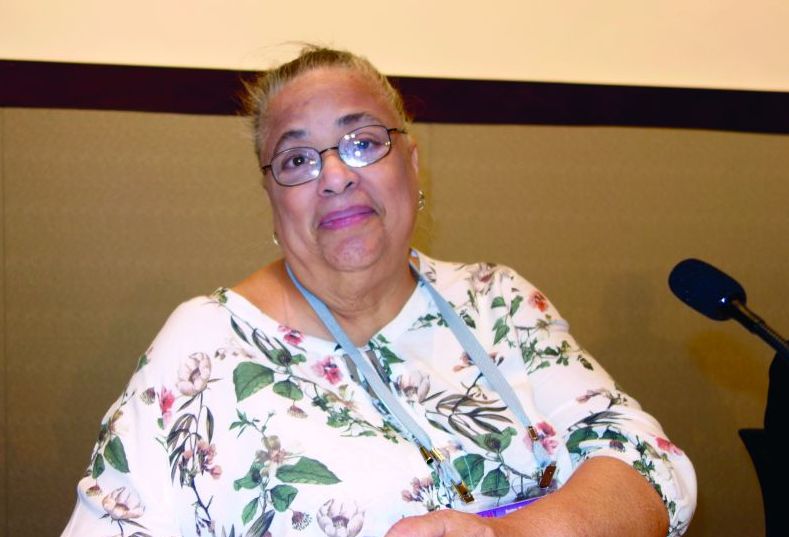User login
BOSTON – More than 1.1 million Americans are at substantial risk for HIV and would benefit from preexposure prophylaxis (PrEP), but only 90,000 prescriptions were filled by retail or mail-order pharmacies in the United States from Sept. 2015 to August 2016, according to the Centers for Disease Control and Prevention.
The CDC estimated that 500,340 blacks in the United States have indications for preexposure prophylaxis, but only about 7,000 (less than 1%) filled a prescription during that time. Among an estimated 282,260 Hispanics who might benefit, just about 7,600 (3%) filled prescriptions. Uptake was a bit higher among whites: about 42,000 prescriptions among 303,230 at-risk people (14%).
PrEP uptake might be particularly low among black and Hispanic people because, in addition to the well-known disparities in health care access and other issues: “There’s a stigma with being gay: ‘If I’m taking this drug, does that mean I’m gay?’ ” Dr. Smith said.
To address the problem, “get more serious about HIV testing. You want to find people who are positive, who need to be on treatment. The second step is to find ways to collect risk-behavior data.” That could be as simple as having the nurse ask a few extra questions before the office visit, or adding a few questions to the intake form, she said at the Conference On Retroviruses And Opportunistic Infections.
“You are trying to help patients acknowledge that they are engaging in behaviors that might have exposed them to HIV, and providers need to be able to hear the answers. One of the problems we have is providers who say ‘my patients aren’t like that,’ or ‘this person is married; I don’t need to ask them.’” Another easy way to find at-risk patients is to look at STD history. If a patient has had syphilis, or two episodes of gonorrhea in the past year, you “need to talk to them about PrEP,” she said.
For black and Hispanic patients, “it’s a higher index of suspicion. For example, you take blood pressure in all your patients, but you are also aware that hypertension is more common in African Americans. So if you’re rushed, you are still going to do a blood pressure in African American patients, but maybe not in the young white jogger; you get that next time.” Especially in high-prevalence HIV settings, “every patient should be aware of PrEP. It should be part of the conversation with everybody,” she said.
The CDC used national pharmacy data and estimates of risky behavior to draw its conclusions. Commercial pharmacies account for maybe 90% of all PrEP prescriptions, so the data slightly underestimate the true use numbers. The more than 1.1 million people included an estimated 813,970 gay and bisexual men, 258,080 heterosexuals, and 72,510 intravenous drug users. The ultimate goal of the work is target PrEP interventions where they are needed most. The agency plans to release state-by-state data soon.
CDC funded the work. Dr. Smith didn’t have any disclosures.
SOURCE: Smith DK et al. 2018 CROI, Abstract 86.
BOSTON – More than 1.1 million Americans are at substantial risk for HIV and would benefit from preexposure prophylaxis (PrEP), but only 90,000 prescriptions were filled by retail or mail-order pharmacies in the United States from Sept. 2015 to August 2016, according to the Centers for Disease Control and Prevention.
The CDC estimated that 500,340 blacks in the United States have indications for preexposure prophylaxis, but only about 7,000 (less than 1%) filled a prescription during that time. Among an estimated 282,260 Hispanics who might benefit, just about 7,600 (3%) filled prescriptions. Uptake was a bit higher among whites: about 42,000 prescriptions among 303,230 at-risk people (14%).
PrEP uptake might be particularly low among black and Hispanic people because, in addition to the well-known disparities in health care access and other issues: “There’s a stigma with being gay: ‘If I’m taking this drug, does that mean I’m gay?’ ” Dr. Smith said.
To address the problem, “get more serious about HIV testing. You want to find people who are positive, who need to be on treatment. The second step is to find ways to collect risk-behavior data.” That could be as simple as having the nurse ask a few extra questions before the office visit, or adding a few questions to the intake form, she said at the Conference On Retroviruses And Opportunistic Infections.
“You are trying to help patients acknowledge that they are engaging in behaviors that might have exposed them to HIV, and providers need to be able to hear the answers. One of the problems we have is providers who say ‘my patients aren’t like that,’ or ‘this person is married; I don’t need to ask them.’” Another easy way to find at-risk patients is to look at STD history. If a patient has had syphilis, or two episodes of gonorrhea in the past year, you “need to talk to them about PrEP,” she said.
For black and Hispanic patients, “it’s a higher index of suspicion. For example, you take blood pressure in all your patients, but you are also aware that hypertension is more common in African Americans. So if you’re rushed, you are still going to do a blood pressure in African American patients, but maybe not in the young white jogger; you get that next time.” Especially in high-prevalence HIV settings, “every patient should be aware of PrEP. It should be part of the conversation with everybody,” she said.
The CDC used national pharmacy data and estimates of risky behavior to draw its conclusions. Commercial pharmacies account for maybe 90% of all PrEP prescriptions, so the data slightly underestimate the true use numbers. The more than 1.1 million people included an estimated 813,970 gay and bisexual men, 258,080 heterosexuals, and 72,510 intravenous drug users. The ultimate goal of the work is target PrEP interventions where they are needed most. The agency plans to release state-by-state data soon.
CDC funded the work. Dr. Smith didn’t have any disclosures.
SOURCE: Smith DK et al. 2018 CROI, Abstract 86.
BOSTON – More than 1.1 million Americans are at substantial risk for HIV and would benefit from preexposure prophylaxis (PrEP), but only 90,000 prescriptions were filled by retail or mail-order pharmacies in the United States from Sept. 2015 to August 2016, according to the Centers for Disease Control and Prevention.
The CDC estimated that 500,340 blacks in the United States have indications for preexposure prophylaxis, but only about 7,000 (less than 1%) filled a prescription during that time. Among an estimated 282,260 Hispanics who might benefit, just about 7,600 (3%) filled prescriptions. Uptake was a bit higher among whites: about 42,000 prescriptions among 303,230 at-risk people (14%).
PrEP uptake might be particularly low among black and Hispanic people because, in addition to the well-known disparities in health care access and other issues: “There’s a stigma with being gay: ‘If I’m taking this drug, does that mean I’m gay?’ ” Dr. Smith said.
To address the problem, “get more serious about HIV testing. You want to find people who are positive, who need to be on treatment. The second step is to find ways to collect risk-behavior data.” That could be as simple as having the nurse ask a few extra questions before the office visit, or adding a few questions to the intake form, she said at the Conference On Retroviruses And Opportunistic Infections.
“You are trying to help patients acknowledge that they are engaging in behaviors that might have exposed them to HIV, and providers need to be able to hear the answers. One of the problems we have is providers who say ‘my patients aren’t like that,’ or ‘this person is married; I don’t need to ask them.’” Another easy way to find at-risk patients is to look at STD history. If a patient has had syphilis, or two episodes of gonorrhea in the past year, you “need to talk to them about PrEP,” she said.
For black and Hispanic patients, “it’s a higher index of suspicion. For example, you take blood pressure in all your patients, but you are also aware that hypertension is more common in African Americans. So if you’re rushed, you are still going to do a blood pressure in African American patients, but maybe not in the young white jogger; you get that next time.” Especially in high-prevalence HIV settings, “every patient should be aware of PrEP. It should be part of the conversation with everybody,” she said.
The CDC used national pharmacy data and estimates of risky behavior to draw its conclusions. Commercial pharmacies account for maybe 90% of all PrEP prescriptions, so the data slightly underestimate the true use numbers. The more than 1.1 million people included an estimated 813,970 gay and bisexual men, 258,080 heterosexuals, and 72,510 intravenous drug users. The ultimate goal of the work is target PrEP interventions where they are needed most. The agency plans to release state-by-state data soon.
CDC funded the work. Dr. Smith didn’t have any disclosures.
SOURCE: Smith DK et al. 2018 CROI, Abstract 86.
REPORTING FROM CROI
Key clinical point: To know if patients need PrEP, you first have to ask about at-risk behaviors.
Major finding: About 500,340 blacks have indications for preexposure prophylaxis (PrEP), but only about 7,000 filled a prescription from Sept. 2015-August 2016.
Study details: The findings are based on pharmacy data and estimates of risky behavior.
Disclosures: CDC funded the work. The lead investigator didn’t have any disclosures.
Source: Smith DK et al. 2018 CROI, Abstract 86.

